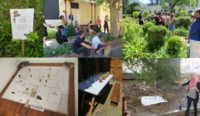Items
Site
The Medicine Chest
keywords is exactly
Where the Wild Things Are
-

Where the Wild Things Are (Field study)
'Where the Wild Things Are' (21 October – 5 November 2014) explored the political, social and historical narratives embedded in the natural world through investigation, observation, mapping, archival research and art making. The exhibition consisted of various on-site interventions engaging with contemporary and historical spatial dynamics and the significance of Hiddingh Campus. The Egyptian Building (home to sculpture workshops and studios) was built on the site of a zoo established in the late eighteenth century that was replete with lion’s dens and a small lake that supposedly housed a hippo. The campus was also the home to UCT’s first Zoology and Botany building (now the Michaelis Building). This historical perspective highlights both the site’s colonial imprints and its early affiliation with the sciences. The UCT campus is divided into its main upper campus, a middle and lower campus, and a few satellite campuses, of which the Michaelis School of Fine Art and the South African College of Music form part. Students drew on the methodologies of artist/curator Mark Dion, collaborating with specialists from upper campus (entomologists, ornithologists and botanists) and Michaelis Fine Art students, to highlight its natural environment. The interventions occurred on different days, and over a two week period. A calendar was provided to stipulate event times and artwork appearances. Curated by Nina Liebenberg Participating artists: Christopher Swift, Dillon Marsh, Fritha Langerman, Thuli Gamedze, Pippa Skotnes, Alex Kaczmarek, Rone-Mari Botha, Jessica Holdengarde, Fanie Buys, Lara Reusch, Stephani Muller, Tegan Green, Evan Wigdorowitz, Mariam Moosa, C J Chandler, Adrienne Van Eeden-Wharton -

Where the Wild Things Are (Installation detail)
WHERE THE WILD THINGS ARE: An Honours in Curatorship Hiddingh Campus field study Curated by Nina Liebenberg 21 OCTOBER – 5 NOVEMBER 2014 'Where the Wild Things Are' explored the political, social and historical narratives embedded in the natural world through investigation, observation, mapping, archival research and art making. The exhibition consisted of various on-site interventions engaging with contemporary and historical spatial dynamics and the significance of Hiddingh Campus. The Egyptian Building (home to sculpture workshops and studios) was built on the site of a zoo established in the late eighteenth century that was replete with lion’s dens and a small lake that supposedly housed a hippo. The campus was also the home to UCT’s first Zoology and Botany building (now the Michaelis Building). This historical perspective highlights both the site’s colonial imprints and its early affiliation with the sciences. The UCT campus is divided into its main upper campus, a middle and lower campus, and a few satellite campuses, of which the Michaelis School of Fine Art and the South African College of Music form part. Students drew on the methodologies of artist/curator Mark Dion, collaborating with specialists from upper campus (entomologists, ornithologists and botanists) and Michaelis Fine Art students, to highlight its natural environment. The interventions occurred on different days, and over a two week period. A calendar was provided to stipulate event times and artwork appearances. Participating artists: Christopher Swift, Dillon Marsh, Fritha Langerman, Thuli Gamedze, Pippa Skotnes, Alex Kaczmarek, Rone-Mari Botha, Jessica Holdengarde, Fanie Buys, Lara Reusch, Stephani Muller, Tegan Green, Evan Wigdorowitz, Mariam Moosa, C J Chandler, Adrienne Van Eeden-Wharton -

Igemfe
"The transverse flute is rarely seen among the Zulu, who, if they make and use it, call it igemfe, the name of a totally different instrument. I possess three specimens, one from Inchanga, one from Pietermaritzburg district, and one from Ixopo. The first two are open at the end opposite the embouchure, and have three finger-holes; the third is a curiously aberrant example, being closed at both ends and having four finger–holes arranged in pairs" (Kirby 2013: 179) Hornbostel-Sachs number: 421.121.32 Stopped side-blown flutes with fingerholes, Length: 291mm (11.4in), Diameter: 36mm (1.2in), Place of production: St. Michael's-on-Sea (KwaZulu-Natal, South Africa).


